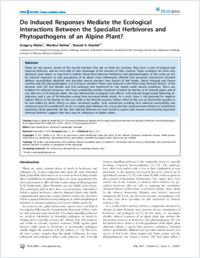Do induced responses mediate the ecological interactions between the specialist herbivores and phytopathogens of an alpine plant?
- Röder, Gregory Laboratory of Evolutionary Entomology, Institute of Biology, University of Neuchâtel, Switzerland
- Rahier, Martine Laboratory of Evolutionary Entomology, Institute of Biology, University of Neuchâtel, Switzerland
- Naisbit, Russell E. Unit of Ecology and Evolution, Department of Biology, University of Fribourg, Switzerland
-
04.05.2011
Published in:
- PLoS ONE. - 2011, vol. 6, no. 5, p. e19571
English
Plants are not passive victims of the myriad attackers that rely on them for nutrition. They have a suite of physical and chemical defences, and are even able to take advantage of the enemies of their enemies. These strategies are often only deployed upon attack, so may lead to indirect interactions between herbivores and phytopathogens. In this study we test for induced responses in wild populations of an alpine plant (Adenostyles alliariae) that possesses constitutive chemical defence (pyrrolizidine alkaloids) and specialist natural enemies (two species of leaf beetle, Oreina elongata and Oreina cacaliae, and the phytopathogenic rust Uromyces cacaliae). Plants were induced in the field using chemical elicitors of the jasmonic acid (JA) and salicylic acid (SA) pathways and monitored for one month under natural conditions. There was evidence for induced resistance, with lower probability and later incidence of attack by beetles in JA-induced plants and of rust infection in SA-induced plants. We also demonstrate ecological cross-effects, with reduced fungal attack following JA-induction, and a cost of SA-induction arising from increased beetle attack. As a result, there is the potential for negative indirect effects of the beetles on the rust, while in the field the positive indirect effect of the rust on the beetles appears to be over-ridden by direct effects on plant nutritional quality. Such interactions resulting from induced susceptibility and resistance must be considered if we are to exploit plant defences for crop protection using hormone elicitors or constitutive expression. More generally, the fact that induced defences are even found in species that possess constitutively-expressed chemical defence suggests that they may be ubiquitous in higher plants.
- Faculty
- Faculté des sciences et de médecine
- Department
- Département de Biologie
- Language
-
- English
- Classification
- Biological sciences
- License
-
License undefined
- Identifiers
-
- RERO DOC 24864
- DOI 10.1371/journal.pone.0019571
- Persistent URL
- https://folia.unifr.ch/unifr/documents/302152
Statistics
Document views: 96
File downloads:
- pdf: 142
